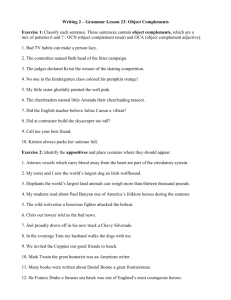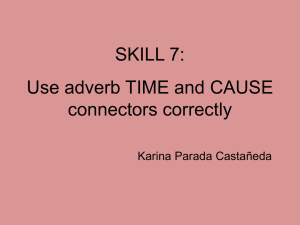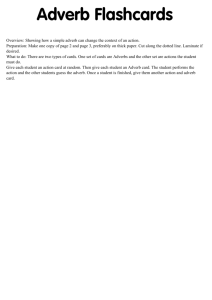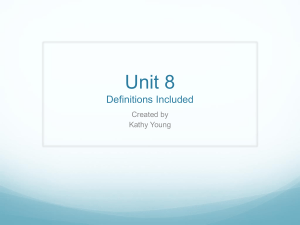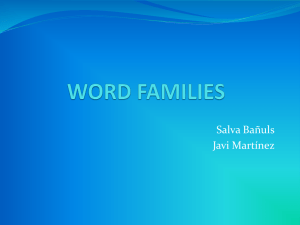Document
advertisement
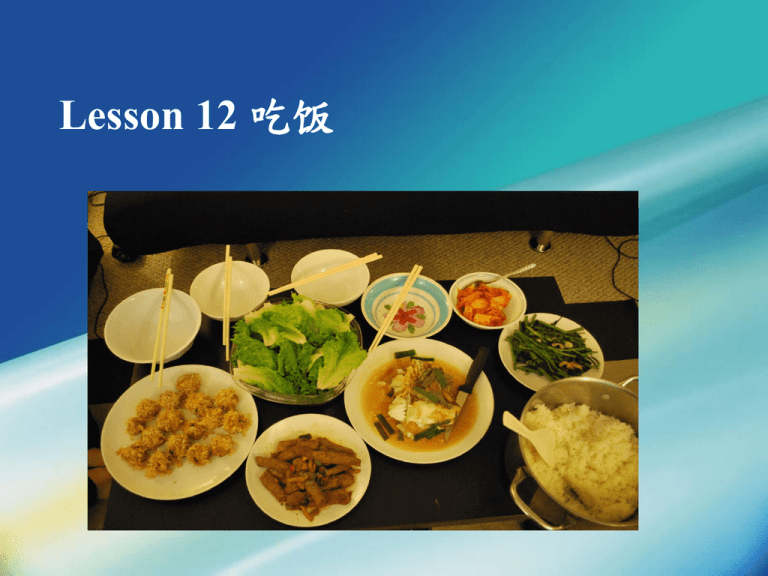
Lesson 12 吃饭 Lesson 12 Objectives Dialogue 1 not at all 一点diăn 也yě 没méi/不bù More or less 多duō vs. 少shăo just now 刚gāng 才cái Resultative Compound (V+Result) foods how to order food Not a single one/not at all/not a bit Sub. + 一 MW 也/都 不/没 V. V + [Num-Measure N] 买衣服 买了[一件衣服] [一件衣服 ] [一件衣服 ] 也 都 没买 没买 Not a single one/not at all/not a bit Sub. + 一 MW 也/都 不/没 V. V + [Num-Measure N] 有朋友 有[一个朋友] [一个朋友] [一个朋友] 也 都 没有 没有 Not a single one/not at all/not a bit Sub. + 一 MW 也/都 不/没 V. Modal V + [Num-Measure N] 会写中国字 会写 [一个中国字] [一个中国字] [一个中国字] 也 都 不会写 不会写 Not a single one/not at all/not a bit Sub. + 一 MW 也/都 不/没 V. V + [Num-Measure N] 吃东西 吃了[一点(儿)东西] [一点(儿)东西] [一点(儿)东西] 也 都 没吃 没吃 Note: if the noun after 一 is countable, a proper MW should be used. If the noun is uncountable, the phrase “一点(儿)” is usually used instead. Adverb 多/少 + V. Adverb 多/少 + V. Adverb 多/少 + V. Adverb 多/少 + V. 刚 (just) vs. 刚才(a moment ago) 刚 (Adv.) Denotes that the action or change in situation took place in the most recent past. 刚才(Noun) vs Refers to the time shortly before the act of speaking. 刚 (just) vs. 刚才(a moment ago) 刚才(Noun) 刚 (Adv.) Can be followed by an expression that indicates the duration of time. vs •Can be followed by the negation words 不 or 没。 •Often ends with 了。 刚 or 刚才? 我____洗完 澡,舒服极 了。 刚 or 刚才? 姐姐 ____ 吃了 二十个饺子,喝 了三碗酸辣汤。 刚 or 刚才? 我 ____ 不想吃 红烧牛肉,现在 想吃了。 刚 or 刚才? 小王 ____ 去了 图书馆。 V-Resultative (+O) DO 做好了 做完 learn 学会 学完 eat 吃完 吃好 sell 卖完了 write 写完 V-R-O 写完功课 吃完饭 学会中文 Resulatives 完: finished game over/used up/sold out 好: a job done ready to start something else. V: 吃/写/说/听/看/打/做/ Compare: 买 vs. 卖 书买好了吗? 书卖完了吗? V-到 V : look/listen/smell/taste/feel 看/听 VR:see/hear … 看到/看见 听到/听见 V-清楚 V-清楚 (clearly) 看/听/说/写/想/学 懂 我懂了! V+懂: 读/看/听/学 + 懂 我一看就懂了。 我看了很久才懂。 V-Resultative Complements(+O) v. 写,看,听,说, 吃,喝,买,用 … 听,看… 学… 听,看 Complement of result (Vs) Examples: 完 写完功课,看完电 视,喝完咖啡,买 完晚饭… 见 他说的话,我听见 了。 会 这个语法我学会了 。 懂 她念的生词你都听 懂了吗? V-Resultative Complements(+O) v. 看,听,走,说, 找,买,卖,请, … 送,还,寄,卖, 借… Complement of result (Vs) Examples: 到 我看到他写的汉字 了!很漂亮! 给 我的车子送给朋友 了。 V-Resultative Complements(+O) v. 写,说,做,念, … 听,看,写,念, 说,做,教,… 写,做,买,准备 练习,复习,… 张,… 说,看,写,念, 问,教,... Complement of result (Adj.s) Examples: 对 老师教的汉字我都 写对了。 错 对不起,我看错了 ! 好 明天的考试我都复 习好了。 大 眼睛(yan3jing1 =eyes) 张大。 清楚 请你说清楚一点。 Food─Meat 肉类lèi Fish 鱼 Shrimp 虾xiā Pork 猪zhū Beef 牛 Mutton 羊yáng Chicken 鸡jī Turkey 火huǒ 鸡jī Duck 鸭yā Goose 鹅é Seafood 海hăi 鲜xiān + + + + + + + + + 肉 肉 肉 肉 肉 肉 肉 肉 肉 Vegetables 蔬shū 菜 /青qīng 菜 Toufu Cabbage Lettuce Green onion Onion Garlic Ginger Tomato Green pepper Hot pepper 豆腐 白菜 生菜 葱cōng 洋yáng 葱cōng 蒜suàn 姜jiāng 蕃fān 茄qié 青qīng 椒jiāo 辣 椒jiāo Rice Flour Noodle Bread Dumpling Stuffed bun wonton Char siu 米 > cooked 饭 面粉fěn 面 /面条 面包bāo 饺子 包bāo 子 馄hún 饨tún 叉chā 烧shāo Measure word Bowl Dish plate Pot 一碗 一盘pián/道 一碟dié 一锅guō Hot pot 大 /小 火huǒ 锅guō 一大盘 /碗 一小碟dié/锅guō 一碗饭 一盘pián/道菜 一碟dié 辣 椒jiāo 一锅guō 汤 How to order 您想吃什么? 我想吃 牛肉。 我要一个葱cōng 爆bào 牛肉。 给我一盘饺子。 还要一盘家常豆腐。 你吃辣吗? 我不吃辣!/我吃辣! Are there seats? 有 N 吗? 有位子吗? 有桌子吗? 有没有 N?(A-not-A) 有没有位子? 有没有桌子? Are there still seats? 还有位子吗? =还有没有位子? Yes: 有 那边biān 还有位子。 那边biān 还有一张桌子。 NO: 没有了。 全quán 满măn 了。 没有位子了! What would you like to eat? Waiter: 您两位想吃(点) 什么? Host: ___,请您点菜吧! Guest: 您决jué 定dìng 吧! 我不会点菜。 Host: 我点一个____,您点一 个____。 我们 一人点一个菜。 Guest: 好,我 要 一个 _____ 。 Ask for preferences Q : 您吃素吗? 是的,我吃素。 不,我不吃素。 Q : 您吃辣吗? 吃,我吃辣。 不,我不吃辣。 Q : 您喜欢吃海hăi 鲜xiān 吗? 是的,我喜欢吃 ___ 不,我不喜欢吃 ___ Ways of cooking/different tastes 凉拌 mix 热炒chăo Stir-fry 红烧 stew 清qīng 蒸zhēng steam 油yóu 炸zhà deep-fry 酸 >醋 甜 >糖 苦kŭ 辣 咸xián >盐yán 淡dàn 油yóu (腻nì) 香xiāng 脆cuì
